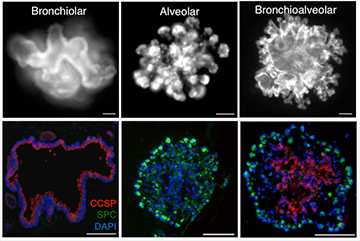
It may be possible one day to treat lung diseases such as emphysema, pulmonary fibrosis and asthma by introducing proteins that direct lung stem cells to grow healthy versions of the specific cell types that are damaged, according to work by Harvard Medical School researchers at Boston Children’s Hospital.
Reporting in the Jan. 30 issue of Cell, a team led by Carla Kim and Joo-Hyeon Lee of the HMS Department of Genetics and the Stem Cell Research Program at Boston Children’s describe a new pathway in the lung, activated by injury, that directs stem cells to transform into specific types of cells—and that can be manipulated to enhance different kinds of repair in mice.
By enhancing this natural pathway in a mouse model, the researchers successfully increased production of alveolar epithelial cells, which line the small sacs (alveoli) where gas exchange takes place. These cells are irreversibly damaged in diseases such as pulmonary fibrosis and emphysema.
By inhibiting the same pathway, the researchers ramped up production of bronchiolar epithelial cells. These cells become damaged in diseases affecting the lung’s airways, such as asthma and bronchiolitis obliterans.
Using a novel 3D culture model that mimics the environment of the lung, the researchers showed that even a single lung stem cell (also known as a bronchioalveolar stem cell) could be coaxed into producing alveolar and bronchiolar epithelial cells.
Adding a protein known as thrombospondin-1 (TSP-1) to these cultures caused the stem cells to go down one pathway and generate alveolar cells. Conversely, adding lung endothelial cells engineered to lack TSP-1 caused the stem cells in the 3D cultures to go down a different pathway and produce more bronchiolar cells.
Kim and Lee conducted further experiments using a live mouse model of fibrosis. In the first test, they took the endothelial cells that line the lung’s many small blood vessels—which naturally produce TSP-1—and injected the TSP-1-rich liquid surrounding them into the mice. They were able to reverse the mice’s lung damage. In the second test, they engineered the fibrosis mouse model to lack TSP-1. The mice showed enhanced airway repair after injury.
“When lung cells are injured, there seems to be a cross talk between the damaged cells, the lung endothelial cells and the stem cells,” said Lee, who is first author on the paper.
“We think that lung endothelial cells produce a lot of repair factors besides TSP-1,” added Kim, the paper’s senior author. “We want to find all these molecules, which could provide additional therapeutic targets.”
The study was supported by the Hope Funds for Cancer Research; the National Heart, Lung, and Blood Institute (U01HL100402; 1U01HL099997; RFA-HL-09-004; RO1HL090136); an American Cancer Society Research Scholar Grant (RSG-08-082-01-MGO); a Basil O’Conner March of Dimes Starter Award; and the Harvard Stem Cell Institute.
Adapted from a Boston Children’s press release.


